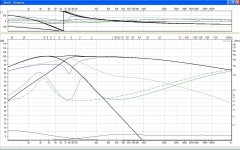That's a significant improvement.
It is and I was surprised to see by how much dispersion was improved. Probably a worthwhile modification for fullrange enthusiasts.
The lower Basotect curves show a 5-6 dB drop in response from 500-1K, and about a 2-3 dB wider response window than the upper curves using the Visaton B200.I actually tried that some time ago with a Visaton B200 and got the best results with a 5cm hole. 0°-40°, no foam (upper curves) vs. 5cm Basotect (lower curves):
An externally hosted image should be here but it was not working when we last tested it.
If I'm reading correctly, you are comparing two different drivers, both of which will have different dispersion, the bottom driver using a 5 cm. foam hole.
Could you post the response of the Basotect driver without the 5cm hole so we could compare what the foam hole does compared to the stock driver response?
Thanks,
Art
re:'If I'm reading correctly" - I don't think you are, same driver, 'Basotect' is the foam...
a new way of doing BSC?
a new way of doing BSC?
re:'If I'm reading correctly" - I don't think you are, same driver, 'Basotect' is the foam...
a new way of doing BSC?
Interesting thought.
FWIW boys, here's a foam termination collar I used on a JBL PT waveguide/horn, it improved pattern control below the horn's cutoff, and removed mouth diffraction artifacts likewise. Both in limited way, but it was a significant and audible improvement.
An externally hosted image should be here but it was not working when we last tested it.
Interesting thought.
FWIW boys, here's a foam termination collar I used on a JBL PT waveguide/horn, it improved pattern control below the horn's cutoff, and removed mouth diffraction artifacts likewise. Both in limited way, but it was a significant and audible improvement.
Yeah, I think foam is well known for controlling diffraction. I'm curious about the piece of white foam you stuck in the horn throat. What's up with that?
Nice foam surround, Mr. Bad. That's what I call the "Mad Dog" treatment (foam at the mouth). I've used beach towels, foam, faux fur, felt, pillows. It all works and makes an audible and measurable difference.
Nice foam surround, Mr. Bad. That's what I call the "Mad Dog" treatment (foam at the mouth). I've used beach towels, foam, faux fur, felt, pillows. It all works and makes an audible and measurable difference.
😀
I think it's much easier to slap some foam on the baffle than to do all of that creative sculpting to make all the corners and edges into large radius curves.
I still wonder if this foam donut thing causes a substantial reduction in diffraction at the woofer's baffle hole in guitar speakers. I assume it would and that it's also part of the effect that is experienced and measured with them installed. The baffle hole for the woofer in guitar amps usually has a really sharp edge to it.
'the "Mad Dog" treatment (foam at the mouth) ' LOL,
'I'm curious about the piece of white foam you stuck in the horn throat' - that must be the deep throat treatment....
'I'm curious about the piece of white foam you stuck in the horn throat' - that must be the deep throat treatment....
So, I've decided to keep the 12PE32's and match them up with the DE250/ME45 horn, crossing over at 1kHz or thereabouts. Active crossover @ 24dB. For the lowest octaves, I'm using the Dayton reference 12" subwoofer and the O Audio BASH plate amp in each box. Each loudspeaker will then be 44" tall or so, 16" square, give or take, about 3.5 cu ft total per box. The baffle will be covered with 1/2" sonic barrier. Here's hoping!
So, the ME10/DE10's and the D54's are for sale on eBay.
So, the ME10/DE10's and the D54's are for sale on eBay.
Here's the combined response of the 12PE32 and Dayton 12" subwoofer. The 12PE32 is cruising along at 1 watt whereas the Dayton needs 10 for the same SPL. I think it's pretty good in simulation anyway. The Dayton has a 24dB active filter set to 70Hz. Hmmm, I can't remember if the O Audio has that kind of filter in it...
Attachments
Yeah, I think foam is well known for controlling diffraction. I'm curious about the piece of white foam you stuck in the horn throat. What's up with that?
Hope you don't get a letter from u no who's lawyers
The foam in the throat is reticulated aquarium filter foam, and strictly speaking is yellow colored. It's intended to remove HF standing waves/reflections in the throat, AKA HOMs. This is just a duplication of Dr. Geddes efforts in filling his whole waveguides with foam. Certainly his work was the impetus for my own efforts in this regard.
No letter necessary, the good Dr. knows I'm using foam in this application, for starters, secondly, his patent requires, IIRC, 80% fill rate to be applicable. There is prior art using foam, just not full-up the way he does, and usually more for protection than for limiting HOMs. It creates a small rolloff at the very top end, but a huge audible effect. Strongly recommended.
- Status
- Not open for further replies.
- Home
- Loudspeakers
- Multi-Way
- Dispersion control with foam
